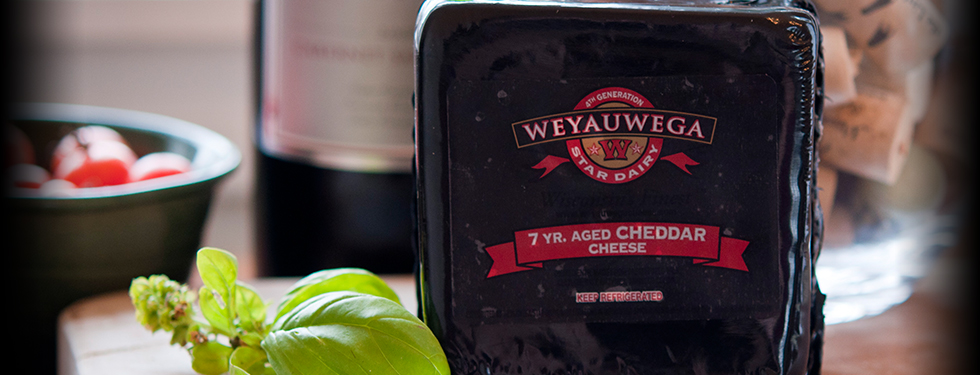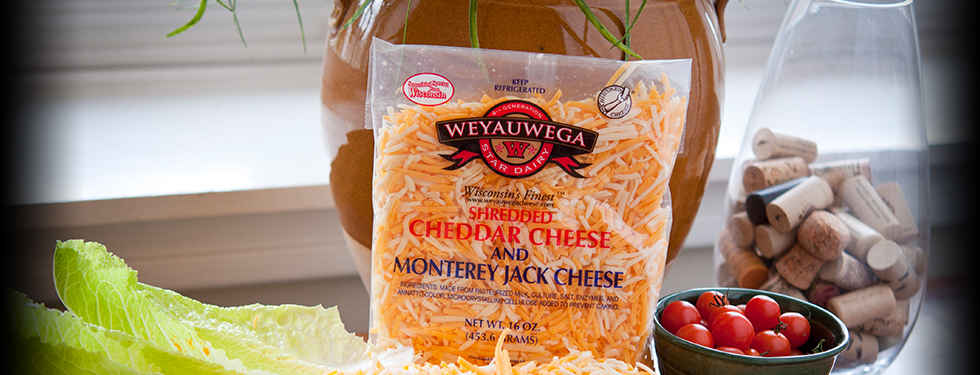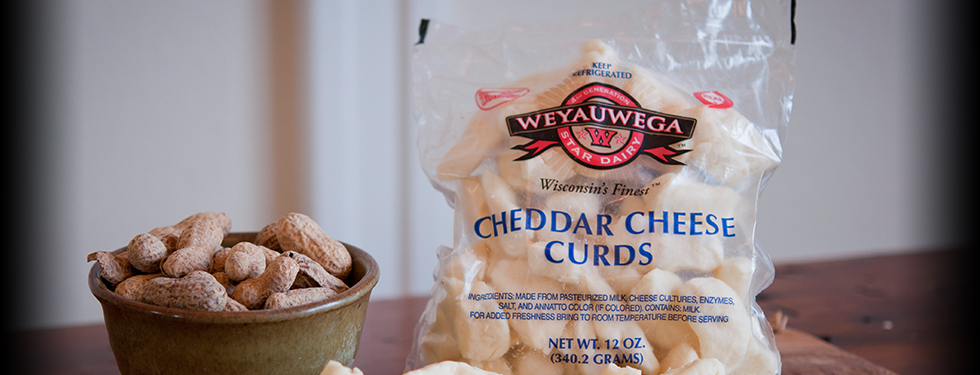Weyauwega All-natural Cheese Products
We offer a wide selection of top-quality cheese, all crafted in Wisconsin. Whether you choose feta, blue, Parmesan, or another of our 18 varieties, you can count on Weyauwega cheese to be all natural and delicious!
Asiago

Young Asiago cheese is famous for its sweet, mild flavor. When aged, it develops a rich, almost spicy quality. The longer Asiago cheese is aged, the firmer its texture becomes and the flavor grows stronger. Historically, this cheese is crafted in specialized groups of local dairies that provide premium quality, alpine grass-fed cow’s milk. Fruit beautifully complements young Asiago, while aged Asiago pairs well with pasta and salads. This cheese is perfect with red wines like merolt, Chianti and malbec.
Texture: Hard
Color: Off-white or yellow
Milk: Cow
Origin: Italy
Baby Swiss

Milder than traditional Swiss cheese, baby Swiss is a semi-soft cheese with a slightly sweet, buttery flavor. It’s origins stem from mid 19th century America, when Swiss immigrants began making the cheese with milk from neighboring Amish family farms. Baby Swiss has a shorter curing time than traditional Swiss, which is the cause of its smaller holes and milder taste. This cheese is perfect for sandwiches, fondues, omelets, quiche and pasta. It also pairs well with sweet fruits and berries, croissants, muffins, and wines like chardonnay and white zinfandel.
Texture:
Color:
Milk:
Origin:
Blue

Blue cheese is well known for its tangy, spicy and salty flavor. It is easily distinguished by the blue streaks that run throughout the cheese. It’s common knowledge that these are blue streaks of mold, but did you know it’s believed that blue cheese was created by accident? Our blue cheese has the perfect temperament for salads, dips, pasta dishes, omelets, crepes and soufflés. It also pairs well with sweet fruit, and is complemented by wines like cabernet sauvignon, red zinfandel and ice wines.
Texture: Soft, sometimes crumbly
Color: White with blue veins
Milk: Cow, sheep or goat
Origin: Various
Cheddar

Cheddar is an amazing cheese. In its youth it offers a smooth texture with creamy flavor. As it ages, cheddar cheese becomes crumbly in texture, and more sharp and full-bodied to the palate. We offer a variety of cheddar cheese choices including mild (aged for XX months), sharp (aged for x years) and extra sharp (aged for xx years), to suit your taste and your recipe.
Cheddar production began in Wisconsin during the mid 1800s, and quickly became the most widely crafted cheese in the state. To this day, Wisconsin is the leader in America’s cheddar cheese production. Weyauwega has been making cheddar for over 100 years, and our experience shines through in every bite. This type of cheese pairs well with beef, dried fruits, nuts, apples — and a variety of red wines including Merlot and Malbec.
Texture: Semi-hard
Color: Pale yellow or orange
Milk: Cow
Origin: Cheddar, Somerset, England
Colby Jack/Diamond Marble

The combination of Colby and Monterey Jack cheese offers a buttery, sweet and slightly tart flavor. The texture is smooth and creamy, and its marbled color combination of orange and white makes it easy to distinguish. Colby-Jack was invented when two vats of cheese, one Colby and one Monterey Jack, were blended together prior to pressing. Colby Jack cheese is perfect for soups, sauces, salads, sandwiches and casseroles. It’s an excellent melting cheese, making it perfect for nachos, and it pairs well with wines like Beaujolais, Chardonnay and Merlot.
Texture: Semi-hard
Color: Marbled orange and white
Milk: Cow
Origin: Arena, Wisconsin
Colby

Colby is a mild cheese that was originally called Colby cheddar, due to its similarity in flavor to mild cheddar. But Colby offers two distinct differences from cheddar: it has a higher moisture content and a more elastic texture — which gives the cheese an identity of its own. A Wisconsin original, Colby cheese was invented in Colby, WI, in 1885. It’s great for snacking, salads or sandwiches, plus it’s perfect for grating and grilling. Colby cheese pairs well with beef, chicken, apples, pears and rye breads. It’s also a perfect companion to Cabernet Sauvignon, Champagne and Pinot Noir.
Texture: Hard
Color: Orange
Milk: Cow
Origin: Colby, Wisconsin
Feta

Feta is well known for its tart, salty flavor and crumbly, moist texture. Although originally made in Greece from sheep or goat milk, Wisconsin artisans make Feta cheese from cow milk. Feta is often referred to as the “pickled” cheese because it’s packed in brine (salt and water) for 4-6 weeks. The brining process helps prolong the freshness of the cheese for approximately six months longer than typical fresh cheeses. This versatile cheese is delicious with salads, baked dishes, olives, beef and vegetables. It pairs well with wines like red zinfandel, Riesling and sauvignon blanc.
Texture: Moist
Color: White
Milk: Cow, Sheep, Goat
Origin: Greece
Fontina

Fontina cheese offers nutty, mild and buttery flavor with a touch of honey. It has a smooth texture that makes it an excellent melting cheese. Fontina was created in Italy’s Val d’Aosta region near the Swiss border in 1477, although some documentation claims production began as early as 1270. Extremely versatile, it makes an outstanding choice for both table cheese and cooking cheese. Fontina cheese is a wonderful addition to French onion soup, sandwiches, salads, desserts and appetizers. In addition, mushrooms bring out the earthy, nutty flavor of the cheese. It pairs well with wines like chardonnay, Riesling and Syrah/Shiraz.
Texture: Semi-soft
Color: Pale yellow
Milk: Cow
Origin: Fontina Val d'Aosta, Italy
Gouda

Gouda cheese offers a wide spectrum of flavor depending on how long it’s aged. Young Gouda is nutty, buttery — and most of all mild. Gouda aged past one year develops an increasingly complex, robust flavor. The texture of the cheese is also affected by its age. As it dries out, it becomes more firm and darkens in color. Dutch cheesemakers call Gouda "how-da," and have been exporting the cheese since the 13th century. There’s a famous Dutch dish called “kaasdoop,” which is a Gouda fondue served with potatoes and rye bread. Gouda is delicious with apples, meats, nuts and dark breads. It pairs well with Champagne, merlot and Fino or Oloroso Sherry.
Texture: Semi-soft
Color: White to creamy yellow
Milk: Cow
Origin: Gouda, South Holland
Havarti

The flavor of Havarti cheese varies from sweet to sharp, depending on the variety and the age of the cheese. Notable for its buttery aroma, it’s generally aged for approximately three months. The longer Havarti is aged, the more it develops a stronger taste with hints of hazelnut. The texture of the cheese is smooth, and it is well suited for melting. In the 1850s, a Danish woman named Hanne Nielsen created Havarti cheese. After traveling to many parts of the world to explore the art of cheese making, she returned home to her husband, and her farm, where she crafted the first batch of this popular cheese. Havarti is well complemented by figs, poultry, dried fruits, walnuts and hearty breads. It pairs well with chardonnay, red zinfandel and sauvignon blanc.
Texture: Semi-soft
Color: Pale yellow
Milk: Cow
Origin: Denmark
Monterey Jack

Monterey Jack is a delicate, buttery and mild cheese with a hint of tartness. Its texture is creamy and open, and it is an excellent melting cheese. It is believed that this cheese was created by Spanish Franciscan friars that came to Monterey, CA, from Mexico in the 1700s — although Scotsman David Jacks is widely credited with first producing Monterey Jack in the same region in the 1890s. Popular in Mexican and Tex-Mex dishes, Monterey Jack is often blended with cheeses like cheddar and Asadero. It goes well with beef, pork, poultry, olives and water crackers. It pairs well with chardonnay, merlot, sauvignon blanc.
Texture: Semi-soft
Color: White
Milk: Cow
Origin: Monterey, California
Mozzarella

Mozzarella offers a delicate flavor that’s milky and mild. Great for melting, its texture is soft and moist when fresh, and more dense when packaged. Whole milk mozzarella is richer in taste and is excellent for baking, while part-skim mozzarella is lighter in flavor and browns faster in the oven. Mozzarella cheese became popular in the United States after World War II, when American GIs returned home with stories of a fantastic new food they discovered in Italy … pizza. Beyond making pizza delicious, mozzarella also complements poultry, pasta, crusty breads and vegetables — especially fresh tomatoes and basil to make a Caprese salad. It pairs well with chardonnay, Chianti and pinot noir.
Texture: Soft, chewy
Color: White
Milk: Cow or water buffalo
Origin: Naples, Italy
Muenster

The flavor of Muenster cheese varies from mild to strong, depending on how long it’s aged. Mild Muenster is odorless, while stronger varieties have a powerful aroma. Wisconsin Muenster is mild with a firm texture that makes it the perfect slicing cheese for sandwiches. Excellent for melting, Muenster is easily recognized by its bright orange annatto coating. There is some ambiguity to the history of Muenster cheese. Some believe it originated in Alsace, France, while others claim it was first created in Germany. What we know for sure is that it’s delicious, and it pairs well with apples, pears, beef, poultry, pork and butter crackers. Muenster is complemented by wines like chardonnay, merlot and Sauvignon Blanc.
Texture: Semi-soft
Color: White
Milk: Cow
Origin: United States
Parmesan

Parmesan cheese is well known for its sharp, buttery and nutty flavor. Its hard, granular texture makes it a perfect cheese for grating. Crafted from part-skim milk, Parmesan’s sharp taste comes from aging it for over 10 months. Often referred to as the king of Italian cheese, Parmesan was born in the Reggio and Parma regions of Italy. It’s no surprise that Parmesan is popular in America, but did you know that Wisconsin is the leader in award-winning Parmesan production? This versatile cheese is delicious with salad, olives, pasta, poultry, grapes, honey and nuts. It also pairs well with an abundance of wines including cabernet sauvignon, chardonnay and malbec.
Texture: Hard
Color: Pale Yellow
Milk: Cow
Origin: Italy
Pepper Jack

Pepper Jack cheese offers a rich, zesty flavor for the palate. Jalapeno and Habanero peppers give the cheese its spicy temperament, while mild Monterey Jack balances the heat with delicate, buttery notes. The texture of the cheese is creamy, semi-soft and open — making it perfect for melting, cooking or for sandwiches. It’s the not-so-distant cousin of Monterey Jack cheese, which was first created in Monterey, CA. Pepper Jack is delicious with quesadillas, sandwiches, crackers, hamburgers and grapes. It pairs well with white zinfandel, merlot, chardonnay and pinot noir.
Texture: Semi-soft
Color: White with specks of color
Milk: Cow
Origin: California
Provolone

Slightly tangy when young, provolone cheese has similar qualities to mozzarella, only with a fuller flavor that ranges from mild to sharp. The texture is semi-soft when young, and becomes more granular and harder with age. Provolone is great for melting and for sandwiches. Many modern-day cheesemakers craft provolone in the same style as late 20th century cheesemakers from the northern regions of Italy. This all-purpose cheese pairs well with salami, pepperoni, salads, poultry, dried fruits, nuts and olives. Provolone is well completed by wines like cabernet sauvignon, Chianti and merlot.
Texture: Semi-soft
Color: Pale yellow
Milk: Cow
Origin: Southern Italy
Romano

Salty and sharp, Romano cheese has a flavor that’s more tangy and robust than Parmesan. Its distinctive, hard texture makes it the perfect choice for grating over pastas and salads. Romano cheese has different names based on the type of milk used to produce it. Cow’s milk Romano is called Vaccino, the sheep’s milk variety is called Pecorino, and goat’s milk Romano is called Caprino. Most Wisconsin cheesemakers create Romano with cow’s milk. In addition to being perfect for pastas and salads, Romano cheese also goes well with beef, poultry, pork, dried fruits, pears, nuts, olives and vegetables. It pairs well with cabernet sauvignon, Chianti and merlot.
Texture: Hard
Color: Pale yellow
Milk: Sheep, goat or cow
Origin: Italy
Swiss

Aged for a minimum of 60 days, Swiss cheese is well known for its full, buttery and nutty flavor. An excellent melting cheese, its texture is semi hard and smooth. Although Swiss is famous for its distinctive holes, some variations of the cheese have no holes at all. Swiss cheese with holes is said to have “eyes.” The bigger the eyes, the bolder the flavor! Swiss is delicious with beef, poultry, dried fruits, fig jam, nuts and whole-grain breads. It’s also a perfect cheese for quiche and casseroles. It pairs well with cabernet sauvignon, chardonnay, ice wines and merlot.
Texture: Semi-hard
Color: Pale yellow
Milk: Cow
Origin: United States




